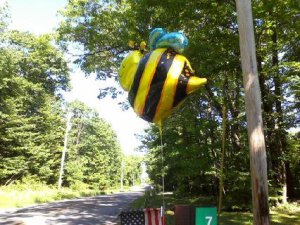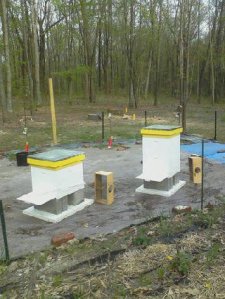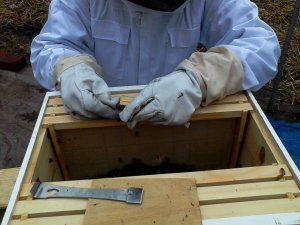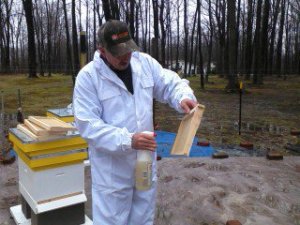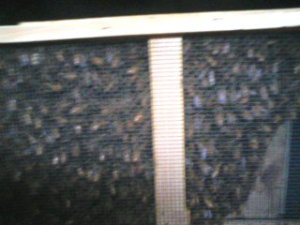He added another “SUPER” to one of the remaining 2 hives this week. Hopefully the bees will fill each one of those with OUR honey. The honey that is already produced in the brooder boxes (should be 100 pounds) will be needed for them to survive the winter months.
14 Jun
Super Dee Duper ! ! !
Curt has added a “SUPER” box to the top of the strongest hive yesterday. I am only sure that it means if we are getting any honey for ourselves and family and friends, it is happening soon !
Definition from Bee Book that I have been quoting: SUPER – any hive body used for the storage of surplus honey; normally placed over or above the brood chamber
6 Jun
Not much to report here
12 May
Added a Brooder Box to one hive
Mr. Curt has added one brooder box to one of the hives today. This week he observed bees going into the hives with their legs covered in yellow pollen!
QUOTING FROM A BEE MANUAL:
During the 1st 21 days after installation into a hive, a package bee colony experiences about a 35% loss in population. This loss occurs because new adult workers require 21 days to develop, during which time the older bees of the existing population die.
After this period, the rate of emergence of young workers begins to exceed the rate of death of older bees and the population grows.
About 4 weeks after installation, the population is completed restored.
Newly hived packaged bees are very susceptible to nosema disease, which often leads to queen supersedure or queenlessness.
About 1 1/2 to 2 months after installation, when the colony requires additional space, you should PLACE ANOTHER HIVE BODY OF FRAMES ON TOP OF THE BROOD CHAMBER, EITHER AS A SUPER FOR SURPLUS HONEY OR FOR BROOD CHAMBER EXPANSION.
1 May
Short report
I was away for the weekend so I do not have much to update other than Curt said one of the hives looks a lot weaker than the other two.
Til later . . . . . .
27 Apr
Looking good :)
26 Apr
Checked the inside of the hives today
Curt and I are now on the opposite work shifts for the next 4 weeks. I am asleep when he gets home from work and he is asleep when I wake up in the morning. : (
So our standard methods of communication are notes on the kitchen counter, phone calls, and text messages.
I received a text message from Curt earlier this afternoon. It said “Queens are almost out and they are making honey”
On the kitchen counter was a note that said “honey bees working on the plant below the front window”
When I got home from work, it started to rain (imagine that!) so I did not get a chance to go back to check it out.
Hopefully tomorrow!
24 Apr
Keeping our fingers crossed
Well, we have had the bees for 24 hours now. Curt keeps going back to check on them. He is calling them our “kids”.
Yesterday afternoon, it did warm up nicely and they were busy flying everywhere.
When we were back there about 7:30 pm today, there was not a bee to be seen! Considering the weather, I do not blame them at all for not being out and about. They are staying in a cluster to keep warm and not leaving the hives. They are thriving off the sugar water that is in the top board feeders.
Curt might have to pull the panels out to see if the queens have exited her special boxes. She needs to start laying eggs as soon as possible because they have a 21 day hatching period. The bees we just got should only have a life expectancy of about 30 days or so. This is a critical time in the establishment of the hives.
Also, the weather needs to do a 360 degree turn around (warmer & sunnier) so the workers will leave the hive boxes and find pollen. Some of the bees have wax glands & will produce wax for combs for the queen to lay her eggs in.
23 Apr
